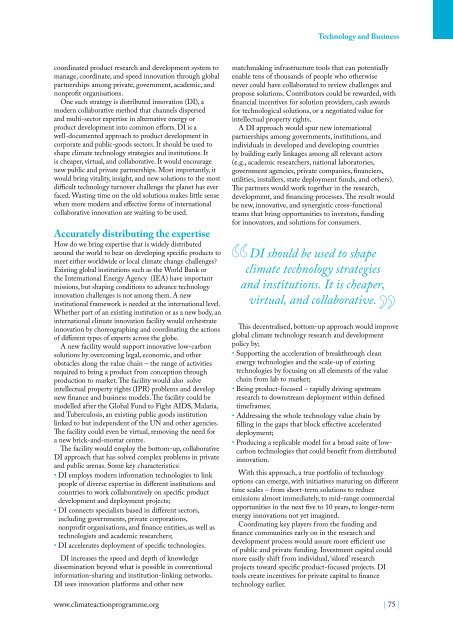Climate Action 2010-2011
Create successful ePaper yourself
Turn your PDF publications into a flip-book with our unique Google optimized e-Paper software.
Technology and Business<br />
coordinated product research and development system to<br />
manage, coordinate, and speed innovation through global<br />
partnerships among private, government, academic, and<br />
nonprofit organisations.<br />
One such strategy is distributed innovation (DI), a<br />
modern collaborative method that channels dispersed<br />
and multi-sector expertise in alternative energy or<br />
product development into common efforts. DI is a<br />
well-documented approach to product development in<br />
corporate and public-goods sectors. It should be used to<br />
shape climate technology strategies and institutions. It<br />
is cheaper, virtual, and collaborative. It would encourage<br />
new public and private partnerships. Most importantly, it<br />
would bring vitality, insight, and new solutions to the most<br />
difficult technology turnover challenge the planet has ever<br />
faced. Wasting time on the old solutions makes little sense<br />
when more modern and effective forms of international<br />
collaborative innovation are waiting to be used.<br />
Accurately distributing the expertise<br />
How do we bring expertise that is widely distributed<br />
around the world to bear on developing specific products to<br />
meet either worldwide or local climate change challenges?<br />
Existing global institutions such as the World Bank or<br />
the International Energy Agency (IEA) have important<br />
missions, but shaping conditions to advance technology<br />
innovation challenges is not among them. A new<br />
institutional framework is needed at the international level.<br />
Whether part of an existing institution or as a new body, an<br />
international climate innovation facility would orchestrate<br />
innovation by choreographing and coordinating the actions<br />
of different types of experts across the globe.<br />
A new facility would support innovative low-carbon<br />
solutions by overcoming legal, economic, and other<br />
obstacles along the value chain – the range of activities<br />
required to bring a product from conception through<br />
production to market. The facility would also solve<br />
intellectual property rights (IPR) problems and develop<br />
new finance and business models. The facility could be<br />
modelled after the Global Fund to Fight AIDS, Malaria,<br />
and Tuberculosis, an existing public goods institution<br />
linked to but independent of the UN and other agencies.<br />
The facility could even be virtual, removing the need for<br />
a new brick-and-mortar centre.<br />
The facility would employ the bottom-up, collaborative<br />
DI approach that has solved complex problems in private<br />
and public arenas. Some key characteristics:<br />
• DI employs modern information technologies to link<br />
people of diverse expertise in different institutions and<br />
countries to work collaboratively on specific product<br />
development and deployment projects;<br />
• DI connects specialists based in different sectors,<br />
including governments, private corporations,<br />
nonprofit organisations, and finance entities, as well as<br />
technologists and academic researchers;<br />
• DI accelerates deployment of specific technologies.<br />
DI increases the speed and depth of knowledge<br />
dissemination beyond what is possible in conventional<br />
information-sharing and institution-linking networks.<br />
DI uses innovation platforms and other new<br />
matchmaking infrastructure tools that can potentially<br />
enable tens of thousands of people who otherwise<br />
never could have collaborated to review challenges and<br />
propose solutions. Contributors could be rewarded, with<br />
financial incentives for solution providers, cash awards<br />
for technological solutions, or a negotiated value for<br />
intellectual property rights.<br />
A DI approach would spur new international<br />
partnerships among governments, institutions, and<br />
individuals in developed and developing countries<br />
by building early linkages among all relevant actors<br />
(e.g., academic researchers, national laboratories,<br />
government agencies, private companies, financiers,<br />
utilities, installers, state deployment funds, and others).<br />
The partners would work together in the research,<br />
development, and financing processes. The result would<br />
be new, innovative, and synergistic cross-functional<br />
teams that bring opportunities to investors, funding<br />
for innovators, and solutions for consumers.<br />
DI should be used to shape<br />
climate technology strategies<br />
and institutions. It is cheaper,<br />
virtual, and collaborative.<br />
This decentralised, bottom-up approach would improve<br />
global climate technology research and development<br />
policy by;<br />
• Supporting the acceleration of breakthrough clean<br />
energy technologies and the scale-up of existing<br />
technologies by focusing on all elements of the value<br />
chain from lab to market;<br />
• Being product-focused – rapidly driving upstream<br />
research to downstream deployment within defined<br />
timeframes;<br />
• Addressing the whole technology value chain by<br />
filling in the gaps that block effective accelerated<br />
deployment;<br />
• Producing a replicable model for a broad suite of lowcarbon<br />
technologies that could benefit from distributed<br />
innovation.<br />
With this approach, a true portfolio of technology<br />
options can emerge, with initiatives maturing on different<br />
time scales – from short-term solutions to reduce<br />
emissions almost immediately, to mid-range commercial<br />
opportunities in the next five to 10 years, to longer-term<br />
energy innovations not yet imagined.<br />
Coordinating key players from the funding and<br />
finance communities early on in the research and<br />
development process would assure more efficient use<br />
of public and private funding. Investment capital could<br />
more easily shift from individual, ‘siloed’ research<br />
projects toward specific product-focused projects. DI<br />
tools create incentives for private capital to finance<br />
technology earlier.<br />
www.climateactionprogramme.org | 75 |












